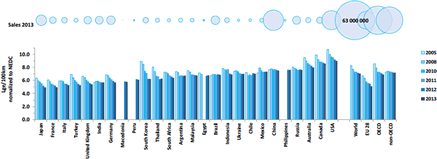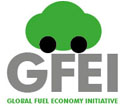
Turkey Developing Automotive Fuel Economy Policy
1.1 Background
Turkey relies heavily on oil imports, covering nearly 90% of domestic demand. Although Turkey does not yet have auto fuel economy standards in place, the national energy efficiency agenda gained a major boost with the 2007 Energy Efficiency Law, followed by regulation on increasing energy efficiency in transportation in 2008. As a candidate country to the EU, Turkey will be responsible for the eventual adoption of EC regulation 443/2009, and industry groups have already initiated discussions in this area. However, this may also mean that Turkey will have to remove restrictions on the importation of used vehicles under an existing bilateral free trade agreement.
IIn 2014, the Global Fuel Economy Initiative published an updated global comparison of auto fuel economy in 26 countries, including Turkey. Average vehicle stock fuel economy went from 5.5 L/100km in 2012 to 5.3 in 2013 (based on the New European Drive Cycle).

1.2 Turkey’s Light-Duty Vehicle Fleet
Turkey is a vehicle production powerhouse – among the top 20 in the world by units produced – and is an export hub for major brands, mainly to European markets. Vehicles have been Turkey’s major export since 2006, reaching 180 countries.
Domestically, relatively low car density combined with strong population growth could result in a swift rise in ownership and, without CO2 emissions standards, a concurrent rise in emissions and energy demand. In early 2011 Turkey adopted European fuel quality standards (going to 10 parts per million sulphur in both diesel and petrol), and Euro 5 LDV standards have been in place from 2010, with Euro VI heavy-duty vehicle standards effective January 2015. As of 2000, all imported and domestically produced cars are equipped with catalytic converters to reduce conventional pollutants.1.3 Status of LDV fleet fuel consumption/CO2 emissions
In 2014, the Global Fuel Economy Initiative published an updated global comparison of auto fuel economy in 26 countries, including Turkey. Average vehicle stock fuel economy went from 5.5 L/100km in 2012 to 5.3 in 2013 (based on the New European Drive Cycle).
2.0 Regulatory Policies
2.1 National Standard
Turkey does not have an auto fuel economy standard, but is likely to eventually follow European standards.
2.2 Test cycle type
New European Drive Cycle (NEDC)
2.3 Import restrictions
New Vehicles
New Vehicles must meet Euro 5/VI emission standard.
Second Hand
The importation of used vehicles is banned in Turkey.
2.4 Technology mandates/targets
3.0 Fiscal Measures and Economic Instruments
3.1 Fuel Taxes
The total tax burden on the pre-tax value of fuel is 195% for petrol and 134% for diesel (in 2009).
3.2 Fee-bate
N/A
3.3 Buy-back
Turkey ran a vehicle buy-back/scrappage programme in 2003-2004 resulting in a reduction of 4.9% in CO2 emissions from the vehicle sector for those two years.
3.4 Penalties
None
3.5 Other tax instruments
Vehicle taxation is proportional to engine size, with larger engines taxed more heavily. This affects the fleet composition, wherein smaller engine cars (under 1600 cc) make up about 60%.
3.6 Registration fees
N/A
3.7 R&D
The 2002 National Research and Technology Foresight Programme (Vision 2023 Programme) identified fuel cells for transport, stationary and portable applications as a research area. See http://www.tubitak.gov.tr/
4.0 Traffic Control Measures
4.1 Priority lanes
N/A4.2 Parking
N/A
4.3 Road pricing
N/A
5.0 Information
5.1 Labeling
The EC Vehicle Labeling Directive was transposed into national legislation in 2009 and emission information is publicly shared by the Ministry of Industry and Trade (MIT). MIT, in cooperation with the Ministry of Environment and Forestry, is responsible for vehicle efficiency and emission standards implementation and enforcement in the country. The Directive has been transposed into Turkish legislation by the by-law on Informing Consumers on Fuel Economy and CO2 Emissions of New Passenger Cars (Official Gazette: 28 December 2003 No. 25330) and entered into force on 1 January 2008. According to Article 10 of the by-law the Ministry of Industry and Trade is responsible for the distribution of information and a guide on fuel economy and CO2 emissions and will perform this task through its provincial directorates. Articles 6 and 7 of the by-law define the requirements for CO2 and fuel economy labels of passenger cars. In addition, according to these articles the manufacturers of the passenger cars are responsible for the preparation of this label. Moreover, the information required in the label is displayed in detail in the Annex I of the by-law.
5.2 Public info
See above.
5.3 Industry reporting
See above.
The text above is a summary and synthesis of the following sources
- Automotive Industry in Turkey, http://en.wikipedia.org/wiki/Automotive_industry_in_Turkey
- Automotive Manufacturers Association of Turkey
- Ernst & Young, The Central and Eastern European Automotive Market, http://www.ey.dk/GL/en/Industries/Automotive/The-Central-and-Eastern-European-automotive-market---Country-profile--Turkey
- Facts and News from EIE/Turkey, May 2007 – February 2011, General Directorate of Electrical Power Resources Survey and Development Administration, Turkey
- “International comparison of light-duty vehicle fuel economy and related characteristics.” IEA/ETP. 10 May 2011. http://www.globalfueleconomy.org/Documents/Updates/Bibendum2011-May2011-IEA-Fuel-Economy-Report.pdf
- International Energy Agency, List of Turkish Legislation, http://www.iea.org/textbase/pm/?mode=pm&action=view&country=Turkey
- Leflaive, Xavier. OECD Eco-Innovation Policies in Turkey. 2008, http://www.oecd.org/dataoecd/28/34/42878896.pdf<
- Turkey National Communication (1st) to the UNFCCC, 2007
- US Energy Information Administration Turkey Profile http://www.eia.gov/countries/cab.cfm?fips=TU








